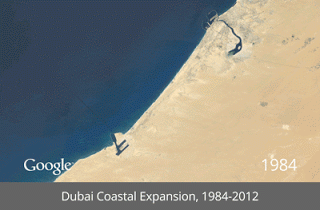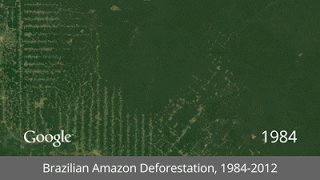Incredible footage taken by storm chasers northeast of Smith Center, Kansas on the same day that a killer tornado levelled Moore, Oklahoma. Filmed by Brandon Ivey and Sean Casey from inside a "tornado intercept vehicle" (TIV) - a tank-like vehicle based on the Dodge Ram 3500 and fitted with 1/8-inch steel plate armour and bullet-resistent Kevlar windows - this video captures the awesome brute force of a large wedge tornado as it passes over the TIV. Watch carefully as several images appear to show creatures and large debris flying by the windshield. Wind speeds were estimated at 280 kph (175 mph).
Visitors
Wednesday, May 29, 2013
Tuesday, May 21, 2013
Great New Project - This is Geography!
Canadian Geographic Education and the Canadian Association of Geographers have joined forces to launch This is Geography," a national campaign to raise the profile of the discipline in Canada. Check out the information below, reproduced here with the permission of CG Education.
Upload your pictures with a description, then give us a head's up in the comments section so we can go and take a look.
| |||||
© 2013 Canadian Geographic Education (reproduced here with permission)
Tuesday, May 14, 2013
Google Timelapse
A friend put me on to a couple of fantastic articles on Google’s latest offering – Google Timelapse.
The first article, written by Jeffrey Kluger, can be found on Time’s website: Timelapse.
Aman Kazemi has also written on Timelapse for CBC. See “Google’s new Timelapse Feature showcases the changing globe”
Timelapse lets you go anywhere in the world and mark geological and urban changes over a 26 year period between 1986 and 2012.
The project is part of an ongoing collaboration between the USGS and NASA called Landsat, which consists of millions of satellite images of the earth's surface. Google compiled these into 1.8 trillion pixels per frame images, which, according to the Time feature, is "the equivalent of 900,000 high-def TVs assembled into a single mosaic."
The result is incredible – a seamless moving image of our changing earth – and will serve as a powerful tool for teaching students about the implications of human-environment interactions
The result is incredible – a seamless moving image of our changing earth – and will serve as a powerful tool for teaching students about the implications of human-environment interactions
To highlight the technology's capabilities, the project's designers have featured a handful of geographical locations that help to illustrate the technology's potential in a particularly vivid way.
A couple of the best examples include:
The Retreat of the Columbia Glacier in Alaska
Urban Sprawl in Las Vegas
Dubai Coastal Expansion
Amazon Deforestation
Thursday, May 9, 2013
Interesting Information on Immigration in Canada for the Classroom
Maps: Where immigrants settled in the GTA
http://www.thestar.com/news/immigration.html
These maps are based upon Statistics Canada data from the 2006 census to track changes in diversity since before 1941. The maps provide the most comprehensive — some say the last complete — snapshot of immigration patterns across the GTA.
They paint a picture of a major shift in immigration to the GTA beginning in the 1960s and growing rapidly each consecutive decade, from mostly European immigration to, in the last census period, natives of India, China, the Philippines and Pakistan.
According to the StatsCan data, 2.4 million immigrants have made the GTA their home since before 1941. The maps confirm for the first time what we’ve known anecdotally for years — that the GTA is home to the world.
These maps are based upon Statistics Canada data from the 2006 census to track changes in diversity since before 1941. The maps provide the most comprehensive — some say the last complete — snapshot of immigration patterns across the GTA.
They paint a picture of a major shift in immigration to the GTA beginning in the 1960s and growing rapidly each consecutive decade, from mostly European immigration to, in the last census period, natives of India, China, the Philippines and Pakistan.
According to the StatsCan data, 2.4 million immigrants have made the GTA their home since before 1941. The maps confirm for the first time what we’ve known anecdotally for years — that the GTA is home to the world.
Interactive Immigration Timeline
Toronto’s immigrant enclaves spread to suburbs
Immigrant underclass in GTA fuels simmering frustrations
2011 census: Nearly one in five Canadians are visible minorities, StatsCan reports
Canada’s Most Diverse Community According to Stats Canada
Graphical Highlights from Statistics Canada National Household Survey
Immigrants in Cities – Charts by CMA
Aboriginal population young and growing fast
Immigration dramatically changing makeup of Toronto and Canada
Just to make things interesting, an article that calls into question the validity of historical comparisons since the elimination of the mandatory long form census.
Statistics Canada disclaimer warns of ‘non-response error’
Tuesday, May 7, 2013
Check Out “Genesis” Exhibit at the Royal Ontario Museum
It is well worth the time to check out the “Genesis” Exhibit currently on display at the ROM
Brazilian landscape photographer Sebastião Salgado’s exhibit “Genesis” opened on Saturday May 4, at the Royal Ontario Museum, Toronto. This fantastic exhibit is made up of over 200 black-and-white photos, taken by Salgado over an eight year period, showing landscapes, wildlife and human communities as yet untouched and unspoiled by modern society.
Featured areas include Antarctic, the Galapagos, Indonesia, Madagascar, the Kalahari, Southern Sudan, Ethiopia, northeastern Alaska, Utah, Siberia and the Amazon
The exhibit runs from May 4th until September 2nd.
Friday, May 3, 2013
Big Think - Big Ideas about our Planet
Great website. Lots of great stuff for Geography, History, Economics, Law, Politics and courses in the Social Sciences and Humanities.
Features include over 12,000 videos featuring experts from a wide variety of disciplines, and links to world renowned bloggers who provide insights and analysis of the “big ideas” in the news.
I particularly like the Frank Jacobs’ blog “Strange Maps.” http://bigthink.com/blogs/strange-maps
______________________________________________________________________________
“We live in a time of information abundance, which far too many of us see as information overload. With the sum total of human knowledge, past and present, at our …fingertips, we’re faced with a crisis of attention: which ideas should we engage with, and why? Big Think is an evolving roadmap to the best thinking on the planet — the ideas that can help you think flexibly and act decisively in a multivariate world.
A word about Big Ideas and Themes — The architecture of Big Think
Big ideas are lenses for envisioning the future. Every article and video on bigthink.com and on our learning platforms is based on an emerging “big idea” that is significant, widely relevant, and actionable. We’re sifting the noise for the questions and insights that have the power to change all of our lives, for decades to come. For example, reverse-engineering is a big idea in that the concept is increasingly useful across multiple disciplines, from education to nanotechnology.
Themes are the seven broad umbrellas under which we organize the hundreds of big ideas that populate Big Think. They include:
- New World Order
- Earth and Beyond
- 21st Century Living
- Going Mental
- Extreme Biology
- Power and Influence
- Inventing the Future
(Thanks to PDSB colleague K. Anthon for putting me on to this great resource!)
Subscribe to:
Posts (Atom)






